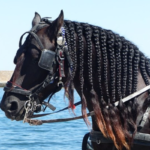Horses are beautiful and majestic creatures but some have certain markings on them which has intrigued horse owners forever. Let’s learn more about them.
The stripes you find on a horse are primitive markings or stripes that are found in distinctive areas of the horse’s body. These areas include their back, ears, tail, shoulders, and legs. These stripes have a zebra-like pattern and run along the horse’s body and are said to determine their hair coat.
Let’s look at some of the commonly asked questions about the stripes that run along a horse’s body.

What do stripes on a horse leg mean?
Horses are of various types and have different defining characteristics. Let’s check out what stripes on a horse leg signify.
Stripes on a horse’s leg signify its underlying coat color. These markings are commonly present around the knees and hocks. They are present right from birth and remain the same throughout the horse’s life. In fact, these stripes can be passed down from parents to offspring.
Leg stripes are commonly found in most horses and can be of different types.
What horses have stripes on their legs?
Although stripes are common among horses, not all horses have them. Let’s understand what horses come with stripes on their legs.
Dun horses are the most common variety of horses with stripes on their legs. These include horse breeds such as Konik, Heck, and Przewalski’s horse. The color and intensity of the stripes varies but these markings are very prominent.
The stripes have a distinct zebra-like pattern and are a defining feature of Dun horses.
What is leg barring on horses?
Also called garters or tiger stripes, leg barring is commonly found in horses. Let’s explore what it is together.
Leg barring on horses are black or reddish points seen above the knee or the hock. These barrings are usually horizontal and are darker than the rest of the horse’s body. Besides, they often have the same color that the mane and tail carry. Leg barrings are commonly found on bay duns.
What are primitive markings in horses?
Horses seldom have a singular color. Often, they carry markings which distinguish them. Let’s define primitive markings in horses.
Primitive markings are stripes and bars present on horses and other animals like donkeys and asses. They are significantly darker than the coat color of the horse and can be present in various parts of the horse’s body, including the legs, shoulder, and head. They are commonly found in dun horses.
Primitive markings can also be less distinctive in non-dun horses but they’re very clearly present in dun horses.
Do gray horses have stripes?
The presence of stripes on gray horses is often debated and there’s been no concrete answer. Let’s find out the truth.
Gray horses may have markings present when they’re born but as they grow older, the markings are hidden by their white skin and can only be visible if their hair is trimmed. Sometimes, these markings may be temporary and fade with age.
That being said, any type of primitive markings is only present in dun horses and are very rare in other varieties.
Do Bay horses have dorsal stripes?
Bay horses are characterized by their reddish-brown coat color and black points. But, do they have dorsal stripes? Let’s find out.
Bay horses do not have dorsal stripes running along their back since they do not carry the dune gene. That being said, there’s a variety called bay dun which contains dorsal stripes. Some bay horses have a black stripe running along their backs but these aren’t true dorsal stripes.
What horses have a dorsal stripe?
A dorsal stripe runs along a horse’s back. Let’s find out which horses have dorsal stripes.
Dorsal stripes are always present on horses that carry the dun gene. Although some non-dun horses may have other primitive markings, a dorsal stripe is a clear, crisp mark that can be found only on dun horses and doesn’t fade over time.
Dun horses also develop fake dorsal stripes that change as the season progresses but these are temporary.
Do Mustangs have primitive markings?
Mustangs are feral horses that roam freely in the Western United States. Let’s find out whether they have primitive markings.
Mustangs have dorsal stripes and leg markings. Some Mustangs also have some other markings but these are not common among the entire breed. The dorsal stripe is usually brown or gray colored but the color can vary depending on the coat color of the horse.
What is a stripe down a horse’s back called?
You might have often noticed a crisp line running down a horse’s back. But have you ever wondered what it is? Let’s find out.
The stripe running down the horse’s back is called the dorsal stripe. It is a prominent line that signifies the horse’s base coat. Often, they can be similar to the color of the mane and tail. It is a very clean and distinctive mark that extends right from the mane up to the dock of the horse’s tail.
Do baby horses have dorsal stripes?
It is a commonly known fact that horses change color as they grow older. But, do baby horses have dorsal stripes? Let’s find out.
Baby horses belonging to the dun breed are born with a crisp and clear dorsal stripe that is either red or brown. However, they are not born with leg stripes and develop those much later, when they’re around 4 months.
Conclusion
Horses are social, beautiful creatures with unique marks that distinguish the species.
Some horses have certain markings that develop due to breeding or as they age, but primitive markings are very distinctive and signify the hair coat of the equine species.
Primitive markings allows specific breeds of horses to become more distinguable and stand out among other horse varieties.




